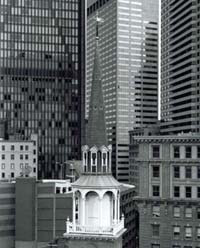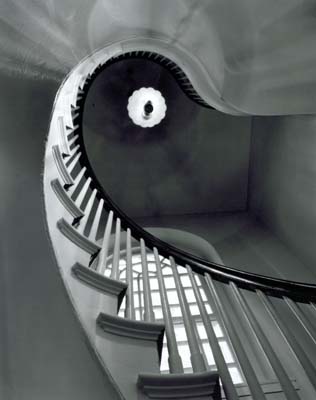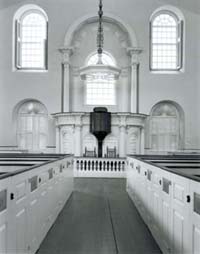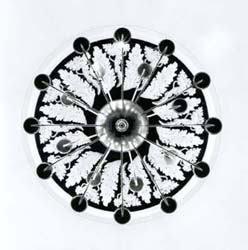| ← back |
Colonial Meetinghouses Featured in this Project |
next → |
 Name of Meetinghouse: Old South Meeting House
Name of Meetinghouse: Old South Meeting House
View on a mapStreet Address of Meetinghouse: 310 Washington Street, Boston, MAYear(s) Built: 1729 National Register of Historic Places Designation: ? Massachusetts State Register of Historic Places: ? Organization responsible: Old South Meeting House Organization's address: 310 Washington Street, Boston, MA 02108 Organization's web site: www.oldsouthmeetinghouse.org Tax status: 501 (C)(3) - tax exempt Contact: Robin D. DeBlosi, Director of Marketing and Events Telephone: (617) 482-6439 x15 E-mail: rdeblosi@osmh.org Acknowledgements: Much of this text has been taken from the publication An Architectural History of the Old South Meeting House, Published by the Old South Association in 1995, and which is available from their Museum Shop.The Old South Meeting House was built as a Puritan meetinghouse in 1729 at the corner of Milk and Marlborough (now Washington) Streets in the Center of Boston. In the nearly 3 centuries since it was built, Old South has served the people of Boston in ways never imagined by its original builders. Today, its steeple stands in stark contrast to the steel and glass skyscrapers that have grown up around it. Its split banner weather vane, which is original, is the second oldest weather vane in the city of Boston.
Although the exterior of the structure looks essentially the same as when it did when it was first built, little information is available today to describe its interior in early years. With a few exceptions, almost none of the original interior survives. Early seating plans indicate that the ground floor was filled with a combination of benches and box pews. Entrances were located in the east, south, and west walls. Two tiers of galleries also occupied these three walls, and a raised pulpit occupied the north wall. Old South's greatest claim to fame is that it was the place from which the Boston Tea Party was planned and organized. Perhaps for this reason, and undoubtedly many other occasions of civic disobedience to the Crown, the British during the American Revolution stripped the interior of Old South, and used it as a horse riding arena. On March 17, 1776, the Continental Army, under the command of George Washington, drove the British out of Boston. The British left the Old South congregation with a building that was unfit for occupancy. Restoring the Meetinghouse was a daunting task, as the congregation was smaller and less wealthy than it had been before the Revolution. This first restoration was completed in 1783. At this time, slip pews were used instead of box pews, and these can still be seen today in Old South.
Old South narrowly escaped the Great Boston Fire in November of 1872. While buildings directly across the street were lost, Old South was saved by a fire company from Portsmouth, New Hampshire. After the fire, municipal authorities used Old South to house soldiers guarding the burned out district from looters. Even before the fire, the congregation had considered leaving the Old South meetinghouse. By that time, the center of Boston was moving west, and in 1875 a new structure was completed in Boston's Back Bay district. While they deliberated on the fate of Old South, the members of the congregation leased the building to the United States government for use as a post office from 1873-75. This again resulted in yet another major renovation. The building was sold at auction in 1876, but local citizens moved quickly to save the building from demolition. On June 14, 1876, a citizens committee was formed, and started fundraising to purchase the building. Through the efforts of the Women's Centennial Committee of Boston, and other prominent Bostonians, the structure was saved, and the underlying land was purchased. The Old South Meetinghouse was the first building in New England to be saved because of its historical significance. Nationally, it was the fourth successful preservation effort. Since its rescue in 1876, Old South has served as a museum and a place for public gatherings. Today, it is a prominent stop along Boston's Freedom Trail. |

|
 The building's original use was both as a place of worship, and a place for public gatherings.
The congregation that built the Old South Meeting House was descended from the Puritans who founded the Massachusetts Bay Colony in the early 17th century.
The Old South congregation built its new meetinghouse as a symbol not only of religious commitment,
but also of wealth and prominence.
The congregation was one of the most prosperous in Boston, which itself was the largest town in the American colonies.
Their new meetinghouse blended elements of both traditional New England meetinghouse design
and stylish Anglican architecture.
The building's original use was both as a place of worship, and a place for public gatherings.
The congregation that built the Old South Meeting House was descended from the Puritans who founded the Massachusetts Bay Colony in the early 17th century.
The Old South congregation built its new meetinghouse as a symbol not only of religious commitment,
but also of wealth and prominence.
The congregation was one of the most prosperous in Boston, which itself was the largest town in the American colonies.
Their new meetinghouse blended elements of both traditional New England meetinghouse design
and stylish Anglican architecture.
 In the early 1800s, Old South continued to be used as a place of worship. In 1857 it was again considerably altered and redecorated
to suit the styles of the times. Following the example of "newer" church buildings, Old South took on an elaborate Victorian design.
The current, very elaborate pulpit is one example of this Victorian influence.
The medallion on the ceiling above the chandelier also dates from this renovation.
In the early 1800s, Old South continued to be used as a place of worship. In 1857 it was again considerably altered and redecorated
to suit the styles of the times. Following the example of "newer" church buildings, Old South took on an elaborate Victorian design.
The current, very elaborate pulpit is one example of this Victorian influence.
The medallion on the ceiling above the chandelier also dates from this renovation.